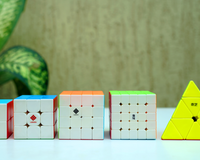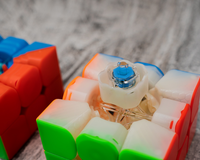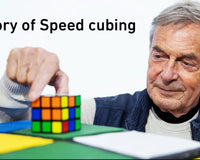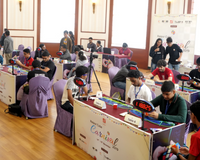Introduction
Getting your first successful solve in your attempt to solve the 3x3 blindfolded is one of the biggest milestones that a cuber can achieve. It brings a sense of achievement and motivates you to get faster at memorizing and executing your solve. The fastest current 3x3 blindfolded single in the world (officially) is 14.51 seconds, achieved by Tommy Cherry. Note that this was inclusive of both memorization as well as execution! That is insane.

How do people get faster?
What is the main difference between a beginner and an expert? Well, the time is obviously a key factor, but what contributes primarily to this time difference? It is interesting to note that the answer to this question is not the memorization technique, but actually the execution technique. This involves how you solve the pieces on the cube, and the efficiency of your solution in terms of number of moves.
The Methods
Old Pochmann (OP) - Beginner
The OP Method was invented by Stefan Pochmann and is widely regarded as the simplest method to solve the cube blindfolded. The main idea is that a PLL (permutation of the last layer) algorithm is used to swap 2 pieces on certain locations on the cube. Each corner and edge is set up based on where it needs to go and the corresponding algorithm (T-Perm for edges and Y-Perm for corners) is executed.
This makes this method a ‘2-cycle’ method, in which each algorithm solves one piece at a time and swaps the ‘buffer’, which is a fixed location on the cube, for the ‘target’, which is where that buffer piece has to go. It is the easiest to understand, since the T-Perm simply swaps edges on thM2e same layer opposite to each other, and the Y-Perm does the same to corners.
What it moved on to
This idea of both edges and corners being solved by a single algorithm for each edge and corner was easy to understand but ended up becoming too long to execute. The average move count came to much over 200 per solve, making this method highly inefficient. There are 12 edges and 8 corners on the cube, and so, they thought of a more innovative way to solve the majority of pieces, i.e. the edges.
M2-OP (M2-Old Pochmann) - Intermediate
The M2-OP method is a hybrid method that is similar to the previous method except for the fact that the edges are now solved using the algorithm M2. Instead of an entire permutation, the edges are now set up to positions across the cube, and swapped using the M2 move, which causes the edge at the buffer location to move to the exact opposite position on the cube.
By using setup moves, the move count for this method is highly reduced and it is as simple as setting up the target location to the position directly opposite to the buffer. This causes a significant reduction in time as well, making it an easy-to-understand yet more efficient method of solving the edges. The corners, being lower in number, don’t impact that time as much by using the PLL algorithm to solve each one.
What it moved on to
It is useful to note that M2-OP is still a 2-cycle method of blindfolded solving, which means that you can still only solve one piece with the use of each ‘swapping algorithm’, so to say. Naturally, the next step from this would be using algorithms that can solve two pieces at once, using just the one algorithm.
3-Style Method
This gave rise to the concept of ‘3-style’, also known as the Bayer-Hardwick (BH) Method. The main idea implemented in 3-style is the use of commutators and/or setups to commutators to solve all possible cases of moving three pieces around on the cube to solve two of them. It gives a much greater sense of efficiency, with the drawback of having more algorithms. This drawback is compensated for by the very low move count (only around 70-80 moves on average). Also, both the edges and the corners are solved in this way, 2 at a time, making it very huge as a method, but helping improve times to a great extent. In addition to this, about 80-90% of the algorithms are intuitive, since commutators are an intuitive concept that are easy to understand!
This drawback is compensated for by the very low move count (only around 70-80 moves on average). Also, both the edges and the corners are solved in this way, 2 at a time, making it very huge as a method, but helping improve times to a great extent. In addition to this, about 80-90% of the algorithms are intuitive, since commutators are an intuitive concept that are easy to understand!
It is arguably the best method out there in terms of both efficiency and ease-of-learning in the context of level of competition.
Is there more?
The 3-style method has 818 algorithms, making it seem like it should be at the end of the spectrum of methods. However, our very own Abhijeet Ghodgaonkar has been working on developing what’s called the ‘5-style’ method, in which we can solve 4 pieces using one algorithm! It is an absolutely insane idea, and all the resources including a plan to get familiar with it can be found here: https://github.com/abunickabhi/5-style
5-Style Method
The ultimate motive of this method is to bring down the length of the solutions to blindsolves to the movecounts of solutions using the CFOP method. While the time to be invested in learning this method (close to 60,000 algorithms at least) is a lot, the outcome and future potential is still unknown, and we are yet to find out how effective this could be in competitive blindsolving!
Conclusion
So, we see that blindsolving methods have been steadily advancing since the inception of the most basic ideas, and this advancement is based on logical progressions from previous ideas. We have come to a stage where the efficiency and performance are attempted to be made maximum, while still remaining within human reach of achieving. It is exciting to see where the future will take us, and this is only beneficial for the vast world of speedcubing.
About Author

Akshaansh Chilakapati
Akshaansh Chilakapati is a speedcuber from Hyderabad who specializes in big cubes. He started cubing when he was 15 and has 5 years of cubing experience. He loves to play sports, and music and has a passion for astrophysics. He has attended 20 competitions and won a total of 64 podiums with 16 gold medals. He is also ranked 13th in India for the overall Sum of Ranks (SOR).































3 comments
Mookie
You forgot that between Pochman/M2 and 3-style, there was R2/M2.
filipe teixeira
@K.Aditya
you can create an account at speedsolving forum and send him a DM
I’m always talking to him through there
K.Aditya
I want 2 learn 3×3 blindfold from abhijeet ghodgaonkar.Can anyone help how to contact him.